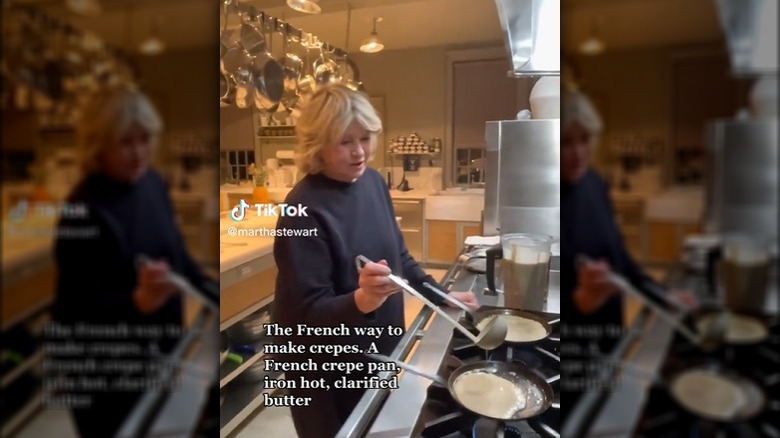Martha Stewart Just Shared Her Technique For Making Perfect Crepes
When people talk about French food, more than a few delicious options usually come to mind. But there's something particularly satisfying about French carbs — think croissants, baguettes, and, of course, crepes. Lovers of fluffy American pancakes might be skeptical of these thin French pancakes, but whether you're eating crepes Suzette (flambéed crepes with a sweet caramelized orange sauce, which is Hugh Jackman's go-to recipe when he wants to impress guests) or prefer a savory crepe recipe, they're hard not to fall for. In fact, crepes are so important in France that every year on February 2 they celebrate Le Jour des Crêpes, or The Day of Crepes (via The Connexion). It's also sometimes called La Chandeleur or Fête de la Lumière, and it's traditional to feast on crepes on this day (per Annie Andre). Delicious, non?
But while ordering crepes at brunch, or from a food stand while walking through the streets of Paris, is easy enough, making them at home can be another matter entirely. Because they're supposed to be so thin, learning how to cook and flip crepes properly so they don't tear or burn can be a challenge. Thankfully, Martha Stewart has shared her technique for getting authentic French crepes every time (she likes to pair hers with "fantastic caviar and crème fraîche"), and it's not as difficult as you might think.
It's all about the technique
Martha Stewart took to TikTok to share "the French way to make crepes." She uses a French crepe pan — "iron, hot" says Stewart — then adds melted clarified butter to the pan once it's hot with a basting brush. Because it's clarified, the butter can withstand high heat without burning or browning. Stewart adds her crepe batter to the pan, swirls it until it covers the entire bottom of the pan, then waits until it gets bubbly on top. She flips it with an offset spatula. The crepes should look lacy and golden brown in spots. She finishes cooking the crepe on the other side until it's just set, which takes very little time.
Stewart prefers iron crepe pans to non-stick. According to BBC Good Food, the benefit of using an iron crepe pan is the quick and even heating that results in crepes cooked perfectly throughout. You should also buy a crepe pan with a low rim, as opposed to that which you'd find on a regular frying pan. This will allow your spatula to reach more easily under the cooking crepes when you're flipping them, explains Cuisine at Home. If you're worried about the maintenance and upkeep of an iron crepe pan, try enameled cast iron, which can withstand high heat but will have less food stuck to it, which is optimal during clean-up according to Good Housekeeping. With the right pan and Stewart's tips, French crepes at home are in your grasp.

